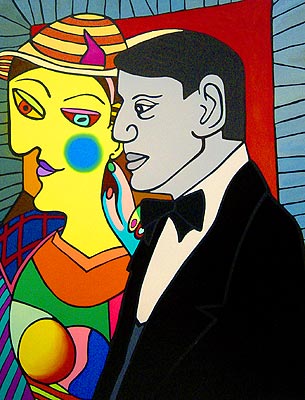How Charles Thomson’s Vision and Leadership Shaped a Global Artistic Movement
The Influence of Charles Thomson
Charles Thomson is a name that may not be as immediately recognizable as some of the more flamboyant figures in contemporary art, but his influence on the art world is profound and far-reaching. As the co-founder of the Stuckist movement, Thomson played a pivotal role in challenging the direction of modern art, advocating for a return to painting and emotional honesty in an era increasingly dominated by conceptualism and commercialism. His contributions as a thinker, writer, and artist have been instrumental in shaping Stuckism into a global movement that continues to resonate with artists and audiences alike.

|
| Charles Thomson - Artist and Model |
Early Life and Artistic Beginnings
Born in 1953 in Romford, Essex, Charles Thomson's early life was steeped in art and literature. He studied at the Medway College of Design, where he developed his skills in painting and an appreciation for traditional art forms. It was during these formative years that Thomson began to cultivate the ideas that would later shape Stuckism. His early work, though grounded in figurative painting, was already marked by a critical eye toward the art establishment, questioning the growing trend of conceptual art that seemed to prioritize ideas over skill and emotional connection.The Birth of Stuckism: Thomson’s Vision
In 1999, Charles Thomson, along with Billy Childish, co-founded Stuckism as a direct response to what they perceived as the hollow and elitist direction of contemporary art. The name "Stuckism" originated from a derogatory remark by Tracey Emin, Childish's then-girlfriend, who accused him of being "stuck" in the past. Rather than reject this label, Thomson and Childish embraced it, turning it into a rallying cry for artists who felt alienated by the prevailing trends in the art world.Thomson’s role in Stuckism cannot be overstated. While Childish provided much of the emotional and creative energy, Thomson was the intellectual architect of the movement. He co-authored the Stuckist manifesto, which called for a return to figurative painting and criticized the conceptual art world for its detachment from genuine human experience. The manifesto articulated a clear vision: art should be about craftsmanship, personal expression, and emotional depth, not about clever ideas or shock value.
Thomson’s Artistic Practice: A Commitment to Figurative Art
Charles Thomson’s own artwork is a testament to the principles of Stuckism. His paintings are characterized by bold colors, clear lines, and a direct approach that mirrors his straightforward philosophy. Unlike many of his contemporaries, Thomson has remained committed to figurative painting, using his work to explore themes of identity, politics, and human nature. His style, though varied over the years, consistently reflects a deep belief in the power of painting to convey emotion and narrative.

|
| Charles Thomson - Woman with a Turquoise Face |
The Global Impact of Stuckism: Thomson’s Leadership
Under Charles Thomson’s leadership, Stuckism quickly grew from a small, London-based group into an international movement. Thomson’s ability to articulate the frustrations and aspirations of like-minded artists around the world was key to this expansion. He organized exhibitions, wrote extensively about the movement, and spearheaded protests that drew attention to the perceived shortcomings of the contemporary art establishment.Charles Thomson’s Legacy: A Lasting Influence
Today, Charles Thomson continues to be a leading figure in the art world, advocating for the values that he and Childish first outlined in the Stuckist manifesto. His influence extends beyond his own work; it can be seen in the continuing relevance of Stuckism as a movement and in the ongoing debates about the direction of contemporary art. Thomson’s commitment to figurative painting, emotional honesty, and intellectual rigor has inspired a generation of artists who feel similarly disillusioned with the mainstream art scene.Charles Thomson’s Enduring Influence on Art
Charles Thomson’s contribution to the art world is both profound and enduring. As the intellectual force behind Stuckism, he has helped to shape a global movement that challenges the norms of contemporary art, advocating for a return to the values of craftsmanship, personal expression, and emotional depth. His work as an artist, writer, and leader has inspired countless others to pursue their creative visions with integrity and passion.In a world where art is often seen as a commodity, Thomson stands as a beacon of authenticity, reminding us that the true power of art lies in its ability to connect us with the deeper aspects of our humanity. His legacy will continue to influence artists and art lovers for years to come, ensuring that the values of Stuckism remain a vital part of the conversation about what art can and should be.



.jpg)







No comments:
Post a Comment